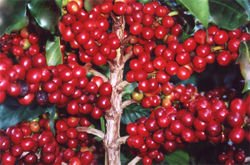Coffea Arabica
DDV CULINARY
Coffea arabica is a species of coffee indigenous to Ethiopia. It is also known as the "coffee shrub of Arabia", "mountain coffee" or "arabica coffee". Coffea arabica is believed to be the first species of coffee to be cultivated, being grown in southwest Arabia for well over 1,000 years. It is still considered to produce the best coffee of the commercially grown coffee species. It contains less caffeine than any other commercially cultivated species of coffee. Wild plants grow to between 7-12 m tall, and have an open branching system; the leaves are opposite, simple elliptic-ovate to oblong, 6-12 cm long and 4-8 cm broad, glossy dark green. The flowers are produced in axillary clusters, each flower white, and 1-1.5 cm diameter. The fruit is a berry 10-15 mm long, maturing bright red to purple, containing two seeds (the coffee 'bean'). Cultivation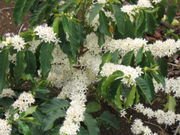
Coffea arabica flowers - Brazil
Coffea arabica takes about seven years to fully mature and does best with 1,000-1,500 mm of rain, evenly distributed throughout the year. It is usually cultivated between 1,300 and 1,500 m altitude, but there are plantations as low as sea level and as high as 2,800 m. The plant can tolerate low temperatures, but not frost, and it does best when the temperature hovers around 20°C (68°F). Commercial cultivars mostly only grow to about 5 m, and are frequently trimmed as low as 2 m to facilitate harvesting. Unlike Coffea canephora (robusta), Coffea arabica prefers to be grown in light shade. Three to four years after planting coffea arabica produces small, white and highly fragrant flowers. The sweet fragrance resembles the sweet smell of jasmine flowers. The flowers that open on sunny days produce the greatest numbers of berries. This can be a curse however as coffee plants tend to produce too many berries; this can lead to an inferior harvest and even damage yield in the following years as the plant will favor the ripening of berries to the detriment of its own health. On well kept planatations this is prevented by pruning the tree. The flowers themselves only last a few days leaving behind only the thick dark green leaves. The drupes, or berries, then begin to appear. These are as dark green as the foliage, until they begin to ripen, at first to yellow and then light red and finally darkening to a glossy deep red. At this point they are called 'cherries' and are ready for picking. The berries are oblong and about 1 cm long. Inferior coffee results from picking them too early or too late, so many are picked by hand. But they are sometimes shaken off the tree onto mats. 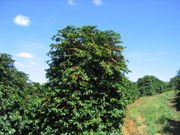
Coffea arabica in Brazil
The trees are difficult to cultivate and each tree can produce anywhere from 0.5-5 kg of dried beans, depending on the tree's individual character and the climate that season. The berries themselves are edible, but the real prize of this cash crop are the beans inside. Each berry holds two locules containing the beans. The beans are actually two seeds within the fruit, there is sometimes a third seed or one seed, a peaberry in the fruits at tips of the branches. These seeds are covered in two membranes, the outer one is called the 'parchment' and the inner one is called the 'silver skin'. In perfect conditions, like those of Java, trees are planted at all times of the year and are harvested year round. In less ideal conditions, like those in parts of Brazil, the trees have a season and are harvested only in winter. Gourmet coffees are almost exclusively high-quality mild varieties of coffea arabica. 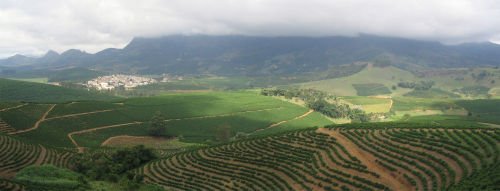
Coffea arabica plantation, São João do Manhuaçu City, Minas Gerais State, Brazil
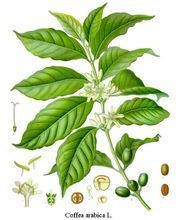
Drawing of Coffea arabica
History and legendAccording to legend, human cultivation of coffee began after goats in Ethiopia were seen becoming frisky after eating the leaves and fruits of the coffee tree. In reality, human consumption of coffee fruits probably began long before humans took up pastoralism. In Ethiopia there are still some locales where people drink a tea made from the leaves of the coffee tree. The first written record of coffee, made from roasted coffee beans, comes from Arabian scholars who wrote that it was useful in prolonging their working hours. The Arab innovation of making a brew from roasted beans, spread first among the Egyptians and Turks and later on found its way around the world. News from current researchBrazilian biologists have found an Ethiopian Coffea arabica that naturally contains very little caffeine. Paulo Mazzafera, a researcher of Universidade Estadual de Campinas, recently published findings in the journal Nature about these strains of Coffea arabica plants. While beans of normal Coffea arabica plants contains 12 milligrams of caffeine per gram of dry mass, these newly found mutants contain only 0.76 milligrams of caffeine per gram with all the taste of normal coffee. Decaffeination processes today throw away about half the beans used in the process, and are considered to have inferior flavors and aroma. But with this discovery, it will now be possible to crossbreed Coffea arabica plants so that a low caffeine coffee can be produced without the waste and harm to the environment that decaffeinated coffee involves today. Literature
It uses material from Wikipedia. |
